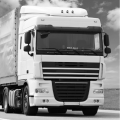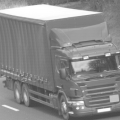The Future of Electric HGVs
What You Need to Know About Going Green
We all know we should do our part for the environment. From recycling and buying secondhand to saving water and reducing plastic use, there’s a lot we can do to live a little greener.
And for those of us in the haulage and logistics industries? HGVs may only represent 1% of all traffic on our roads, but they’re responsible for 20% of the UK’s transport emissions. And according to the International Energy Agency (IEA), the energy sector is responsible for “around three-quarters of greenhouse gas emissions today”. A lot of that comes down to the fossil fuels we use to power our vehicles.
These numbers may be worrying, but don’t lose hope! The good news is that the government is pushing for a greener, cleaner future for the transport industry. They’re already putting their money where their mouth is by investing £120 million to make the switch to zero-emission alternatives.
And that’s not all! By 2035, the sale of new diesel trucks and HGVs will come to an end, and by 2040, all new HGVs sold will be zero-emission. That’s right, in 10-15 years, most drivers in the haulage and logistics industries will use hydrogen fuel cell and battery electric trucks, a major step towards reducing emissions and lowering our carbon footprint.
Why is the industry going green?
There are a few reasons for the push for greener transportation, apart from trying to keep our planet healthy for future generations..
Government regulations
Like many countries around the world, the UK is committed to reaching Net Zero. This means cutting carbon emissions to a small enough amount that they can be absorbed by nature, leaving zero in the atmosphere.
To help make this happen, clean air zones have been introduced in major cities across the country. Vehicles have to meet minimum emission standards to enter these areas, and some zones will charge you if your lorry or car doesn’t meet them. Other areas encourage things like public transport and improving traffic flow to reduce emissions.
Either way, the aim is cleaner air and a healthier environment for everyone.
Rising fuel costs
Over the last few years, we’ve seen huge fluctuations in petrol and diesel prices. During the summer of 2022, prices hit a record high, averaging 191.5p per litre of petrol and 199.09p per litre of diesel.
While prices have come down a little from that spike, they’re still far from cheap. In fact, fuel is still one of the biggest ongoing costs for fleet operators and drivers across the industry.
Fleet operators getting on board
As sustainability becomes a key concern, more transport companies are adopting greener practices to do their part (and win more business in the bargain).
Some big names in the haulage and logistics industries are already embracing electric HGVs and hydrogen-powered trucks. Maritime Transport recently invested in 18 battery-electric lorries, while Explore Transport has secured the first Scania fuel cell electric vehicle prototype in the UK.
As more big companies transition to alternatives like electric trucks, the rest of the industry is starting to follow suit to stay competitive and protect the planet.
Hydrogen vs. Electric HGVs: What’s the difference?
Compared to petrol and diesel-burning lorries, electric HGVs and hydrogen fuel cell electric vehicles are great alternatives. These heavy-duty trucks are powerful, efficient, and environmentally friendly.
So, what’s the difference between the two?
Electric HGVs
These vehicles run on batteries that power an electric motor, replacing the traditional diesel engine. You just plug them in when you’re running low on battery. Kind of like charging your phone!
Hydrogen-powered electric trucks
Unlike electric vehicles that rely on batteries, hydrogen fuel cell vehicles create their own electricity. Hydrogen fuel cells generate electricity by mixing hydrogen and oxygen atoms.
The most common way to produce hydrogen is from natural gas, which isn’t a particularly eco-friendly method. But, it’s possible to make hydrogen more sustainable. ‘Green hydrogen’ is made using renewable sources of energy like wind and solar power.
Plus: Hydrogen-powered vehicles also tend to have longer range and faster refueling times than electric vehicles, making them time and energy efficient!
How does this affect HGV drivers?
It’s not quite as simple as picking out a new hydrogen-fuelled or electric lorry and cruising back into business as usual. There are a few changes to keep in mind.
Training time: You may know a diesel HGV better than the back of your hand, but hydrogen and electric trucks are a little different. You’ll need to learn how to refuel and handle hydrogen safely. And unlike diesel motors, electric vehicles give you maximum torque from the get-go, so it’ll take some getting used to.
Pay and working conditions: Longer charging times for electric HGVs could impact your regular shift length, potentially affecting your pay. But, the upside is that you’ll have quieter journeys, faster acceleration, and no exhaust fumes to deal with.
But even as the industry shifts from fossil fuels to electric and hydrogen alternatives, one thing remains the same: your skills as a driver are still in high demand. Especially if you’re willing to upskill!
Green initiatives for haulage companies: Bumps in the road
We’re all eager to make a positive change to protect the planet, and alternative-fuel vehicles are a major step. But adopting them into the transport industry isn’t without its challenges. Here’s what we’ll need to keep in mind:
Cost: Switching from petrol or diesel-powered to electric HGVs is great for the planet, but the new technology and infrastructure are a massive investment, presenting a challenge to companies eager to go green.
Battery space and charging time: Powering a lorry requires a pretty hefty battery, and the space this battery needs may take up some cargo storage space. Plus, charging the battery takes longer than filling up at the pump, which may disrupt delivery schedules.
Range: With most lorry drivers travelling long distances, a reliable range is essential. While you’d get a range of about 1,200km with a standard diesel HGV, the average electric HGV’s range is only 220km. That’ll mean more stops to recharge, throwing off industry timelines.
Infrastructure issues: The UK currently has just 16 hydrogen refuelling stations, with only 1 public charging point for electric HGVs. We’ve got a long way to go before we have the infrastructure necessary to phase out diesel HGVs and fully support a hydrogen-electric transport industry by 2040!
We may have a long road ahead of us; but we’re no stranger to those! With proper planning, training, budgeting, and infrastructure, we can drive a much more sustainable, eco-friendly transport industry forward.
Stay road-ready with Driver Require
Whether you’ve been a HGV driver for years, or you’re coming into the industry wondering what a greener future means for you, we’re here to help you make sense of it all.
Got questions? Or just fancy a chat? Get in touch with our team. We’re just a call or a click away.
Google Reviews
-
 Dave GallacherGood range of jobs available, decent rates of pay. Always able to get in contact with the office or someone on call with good knowledge and understanding of the job or role sent to. Never had an issue with pay, easy timesheet process
Dave GallacherGood range of jobs available, decent rates of pay. Always able to get in contact with the office or someone on call with good knowledge and understanding of the job or role sent to. Never had an issue with pay, easy timesheet process -
(1).png?r=a2-s120.120-o) Ionel Lucian DinicaVery easy to find work , very nice and kind staff, all details explained very easy. Highly recommended.
Ionel Lucian DinicaVery easy to find work , very nice and kind staff, all details explained very easy. Highly recommended. -
 Catalin SirgheA reliable and efficient agency. I’ve had a positive experience with Driver Require. They have consistently paid on time and have never cancelled a shift. The communication is excellent. If you’re looking for a reliable agency that values its drivers, Driver Require is a great choice.
Catalin SirgheA reliable and efficient agency. I’ve had a positive experience with Driver Require. They have consistently paid on time and have never cancelled a shift. The communication is excellent. If you’re looking for a reliable agency that values its drivers, Driver Require is a great choice.
